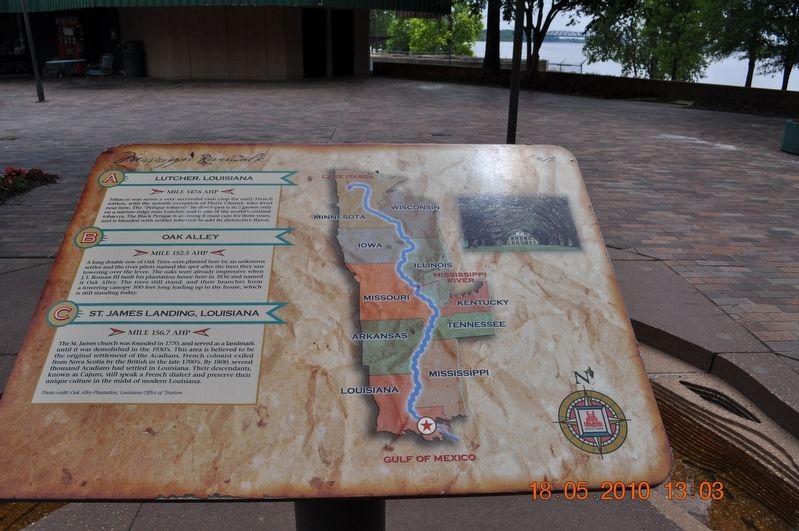Memphis in Shelby County, Tennessee — The American South (East South Central)
Lutcher, Louisiana/Oak Alley/St. James Landing, Louisiana
Panel #12 Mississippi Riverwalk
Inscription.
A) Lutcher, Louisiana
Mile 147.6 AHP
Tobacco was never a very successful cash crop for early French settlers, with the notable exception of Pierre Channet, who lived near here. The “Perique tobacco” he developed is still grown only on a narrow ridge near Lutcher and is one of the world’s costliest tobaccos. The Black Perique is so strong it must cure for three years and is blended with milder tobacco to add its distinctive flavor.
B) Oak Alley
Mile 152.5 AHP
A long double row of Oak Trees was planted here by an unknown settler and the river pilots named the spot after the trees they saw towering over the levee. The oaks were already impressive when J. T. Roman III built his plantation house here in 1836 and named it Oak Alley. The trees still stand, and their branches form a towering canopy 300 feet long leading up to the house, which is still standing today.
C) St. James Landing, Louisiana
Mile 156.7 AHP
The St James church was founded in 1770 and served as a landmark until it was demolished in the 1930’s. This area is believed to be the original settlement of the Acadians, French colonist exiled from Nova Scotia by the British in the late 1700’s. By 1800, several thousand Acadians had settled in Louisiana. Their descendants, known as Cajuns, still speak a French dialect and preserve their unique culture in the mist of modern Louisiana.
Photo credit: Oak Alley Plantation, Louisiana Office of Tourism
Erected by Mississippi Riverwalk. (Marker Number 12.)
Topics. This historical marker is listed in these topic lists: Settlements & Settlers • Waterways & Vessels. A significant historical year for this entry is 1836.
Location. 35° 8.968′ N, 90° 3.507′ W. Marker is in Memphis, Tennessee, in Shelby County. Marker can be reached from Island Drive, 0.8 miles south of West A.W. Willis Avenue when traveling south. Located in Mud Island River Park. Touch for map. Marker is at or near this postal address: 125 N Front St, Memphis TN 38103, United States of America. Touch for directions.
Other nearby markers. At least 8 other markers are within walking distance of this marker. The Mississippi Riverwalk (here, next to this marker); Ohio River (here, next to this marker); Cairo, Illinois (here, next to this marker); Islands No. 2, 3, and 4 / Fort Jefferson, Kentucky / Bird’s Point, Missouri (here, next to this marker); Island No. 5 (Wolf Island)/Belmont, Missouri/Columbus, Kentucky (here, next to this marker); Donaldson Point, Missouri/Island No. 8/Hickman, Kentucky/Dorena Crevasse (here, next to this marker); New Madrid, Missouri/Cates Casting Field/Island No. 10 (here, next to this marker); Tiptonville, Tennessee/Bixby Towhead (here, next to this marker). Touch for a list and map of all markers in Memphis.
Also see . . .
1. Lutcher, Louisiana. Lutcher was established as a sawmill town, named after Henry J. Lutcher who was a sawmill operator and businessman. Lutcher is also where James Mather and his family established a sugar plantation, and where Mather died in 1821.[7] The Bank of Lutcher was organized by George H. Jones, M. D., son of Dr. John Welch Jones.[8] (Submitted on March 12, 2018, by Sandra Hughes Tidwell of Killen, Alabama, USA.)
2. Types of Tobacco. Perhaps the most strongly flavored of all tobaccos is the Perique, from Saint James Parish, Louisiana. When the Acadians made their way into this region in 1755, the Choctaw and Chickasaw tribes were cultivating a variety of tobacco with a distinctive flavor. A farmer called Pierre Chenet is credited with first turning this local tobacco into the Perique in 1824 through the technique of pressure-fermentation. Considered the truffle of pipe tobaccos, the Perique is used as a component of many blended pipe tobaccos, but is too strong to be smoked pure. At one time, the freshly moist Perique was also chewed, but none is now sold for this purpose. It is traditionally a pipe tobacco, and is still very popular with pipe-smokers, typically blended with pure Virginia to lend spice, strength, and coolness to the blend. (Submitted on March 12, 2018, by Sandra Hughes Tidwell of Killen, Alabama, USA.)
Credits. This page was last revised on March 13, 2018. It was originally submitted on March 12, 2018, by Sandra Hughes Tidwell of Killen, Alabama, USA. This page has been viewed 420 times since then and 27 times this year. Photo 1. submitted on March 12, 2018, by Sandra Hughes Tidwell of Killen, Alabama, USA. • Bernard Fisher was the editor who published this page.
Editor’s want-list for this marker. Wide shot of marker and its surroundings. • Can you help?
